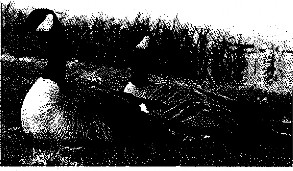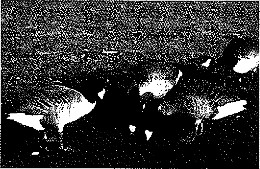Tracks: The webbed feet of the Canada Goose are apparent when looking at their tracks.
Feeding: Canada Geese, like most waterfowl, eat aquatic vegetation, grass, roots and young sprouts. They also eat grain and corn from agricultural areas. They are prolific grazers and can consume about 2 kg (4+ lbs) of grass and produce 1 kg of excrement in an average day.


Used with pennission. © Leanne Guenther
Their preference is fresh green tender plants and grass, much the stuff of manicured mowed lawns.
Habitat: Canada Geese live around ponds, river and lake shores. Stormwater retention ponds are a necessary facility to allow for residential and commercial development and often get naturalized to improve aesthetics, urban calming and recreational opportunities in residential areas.
The _ combination of ponds and associated mowed grass landscape proviqe ideal nesting and forging opportunities for geese. They've become a common sight in city parks where many people enjoy the presents of wildlife but it is when overpopulation occurs that problems start. For this reason municipalities are trying to discourage people from feeding them in the overpopulated areas.
One of the reasons for overpopulation is something called Founder's Effect. Canada Geese will return to the same site as adult breeders that they themselves were fledged from. So a small number of geese allowed to fledge young will quickly become a much bigger population with the young returning as breeders. Another reason for over population is the lack of predators in urban settings. In balanced ecosystems both nest and gosling predators are present keeping populations in check.